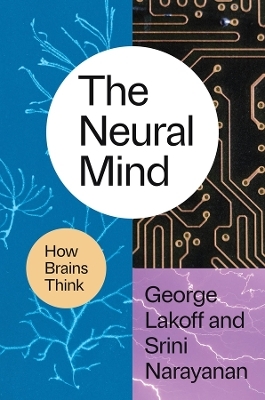
The Neural Mind
University of Chicago Press (Verlag)
978-0-226-83588-4 (ISBN)
- Noch nicht erschienen (ca. Mai 2025)
- Versandkostenfrei
- Auch auf Rechnung
- Artikel merken
What is an idea, and where does it come from? We experience thought as if it were abstract, but every thought is actually a physical thing, carried out by the neural systems of our brains. Thought does not occur neuron-by-neuron; it happens when neurons come together to form circuits and when simple circuits combine to form complex ones. Thoughts, then, derive their structures from the circuitry we also use for vision, touch, and hearing. This circuitry is what allows simple thoughts to come together into complex concepts, making meaning, creating metaphors, and framing our social and political ideas.
With The Neural Mind, George Lakoff, a pioneering cognitive linguist, and computer scientist Srini Narayanan deftly combine insights from cognitive science, computational modeling, and linguistics to show how thoughts arise from the neural circuitry that runs throughout our bodies. They answer key questions about the ways we make meaning: How does neural circuitry create the conceptual “frames” through which we understand our social lives? What kind of neural circuitry characterizes metaphorical thought, in which ideas are understood in terms of other ideas with similar structures? Lively and accessible, the book shows convincingly that the “metaphors we live by”—to use Lakoff’s famous phrase—aren’t abstractions but deeply embodied neural constructs.
The Neural Mind is the first book of its kind, bringing together the ideas of multiple disciplines to offer a unified, accessible theory of thought. A field-defining work, Lakoff and Narayanan’s book will be of interest not just to linguists and cognitive scientists, but also to psychologists, philosophers, anthropologists, journalists, sociologists, and political scientists—and to anyone who wants to understand how we really think.
George Lakoff is professor emeritus of cognitive science and linguistics at the University of California, Berkeley. He is the author or coauthor of numerous books, including Metaphors We Live By, also published by the University of Chicago Press. Srini Narayanan is distinguished scientist and senior research director at Google DeepMind, Zurich, where he leads a research group on machine learning and natural language processing. Until 2014, he was director of the International Computer Science Institute, a core faculty member in the Cognitive Science Program, and a faculty member at the Institute for Brain and Cognitive Sciences, all at the University of California, Berkeley, where he was also a cofounder of the Berkeley Neural Theory of Language group.
Preface
Chapter 1: What It Takes to Create Human Thought
The Creation of Perception: Color
What Are Ideas?
The Brain’s Tool Kit
The Body Is Neural
Dual Models
Generalizations
Functional Generalization
Cascades
Convergence-Divergence Zones
Explaining Basic-Level Concepts
Sound Symbolism
Creating Perception: Seeing, Feeling, and Hearing
The Takeaways
Chapter 2: How Thought Works
From Motor Control to Thought
The Big Surprise: Aspect Is Motor Control
Image Schemas: Starting with Kant
On Schemas
Schema Embodiment
Thinking with Schemas
Frames 00
The 2,500-Year-Old Theory
Conceptual Metaphor
Scales and Their Logic
Primary Embodied Metaphor
Metaphor and Neuroscience
Conceptual Integration and Consciousness
Categories
The Takeaways
Chapter 3: The Neural Mechanisms of Thought
Scope and Challenges
Neural Firing: The Basic Steps
What Is Structured Neural Computational Modeling?
Basic Circuit Types
Coordination and Cascades: Evidence from Behavior Control
Combinatorial Circuits
Multiple Mapping Circuits
Control and Coordination Circuits
Integrative Circuits and Simulation
Simulation in Language and Thought
The Takeaways
Applying the Neural Theory
Chapter 4: Neural Language
Thinking Neurally about Language
Basic Circuit Types in Grammar
The Scope and Power of Ideas in Grammar Due to Circuits for Ideas
Embedding and Composition
The Coordination of Multiple Circuits in Grammar
Lexicon and Grammar
There Is No Natural Language without Meaning
Early Intimations of Integration in Grammar
Case Study 1: One-Anaphora
Case Study 2: Cascades of Metaphors
Case Study 3: Looking Over without Overlooking
Language Types and Embodiment
The Two-Type Language Contrast
How Ideas Spread
Neural Phonology
The Takeaways
Afterword: The Neural Mind versus Deep Learning AI
Acknowledgments
Notes
References
Bibliography
Index
| Erscheint lt. Verlag | 13.5.2025 |
|---|---|
| Zusatzinfo | 15 halftones, 11 tables |
| Sprache | englisch |
| Maße | 152 x 229 mm |
| Gewicht | 454 g |
| Themenwelt | Geisteswissenschaften ► Psychologie ► Allgemeine Psychologie |
| Geisteswissenschaften ► Psychologie ► Verhaltenstherapie | |
| Geisteswissenschaften ► Sprach- / Literaturwissenschaft ► Sprachwissenschaft | |
| ISBN-10 | 0-226-83588-X / 022683588X |
| ISBN-13 | 978-0-226-83588-4 / 9780226835884 |
| Zustand | Neuware |
| Informationen gemäß Produktsicherheitsverordnung (GPSR) | |
| Haben Sie eine Frage zum Produkt? |
aus dem Bereich


